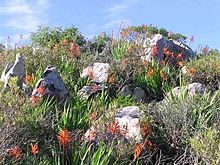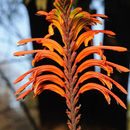Biology
provided by Arkive
The flowers of the greater cobra lily, which bloom from July until September (2), have adapted to pollination by sunbirds (Nectarinia species). The elongated, tubular structure, the bright colours, and the protruding stamens and style, are all designed to ensure that pollen is deposited on the sunbird, or pollen from another plant is rubbed off, as the sunbird inserts its long bill to feed on the relatively large quantities of nectar (4).
The greater cobra lily not only uses birds to carry out pollination, but also to disperse the seeds that are produced following pollination and fertilisation. While the seeds have no fleshy covering or nutritious value, their bright orange colour attracts birds to eat them. The seeds pass through the bird's digestive system relatively undamaged, to be excreted some distance from the parent plant (4).
Conservation
provided by Arkive
Within the Cape Floristic Region, there are a number of protected areas (8), such as the Fernkloof Nature Reserve, in which this species occurs (9). In addition, a number of conservation organisations are working to conserve the botanically rich habitat of the Cape Floristic Region. Conservation actions include purchasing land to protect it from the threats of encroaching agriculture and urban development (10), the removal of alien plants, and the establishment of new protected areas (7).
Description
provided by Arkive
The greater cobra lily is a striking, winter-growing South African plant with sword-shaped leaves that envelope the lower part of the erect stem at their base (4). The distinctive flowers of the greater cobra lily gave rise to its scientific name; floribundus means 'flowering profusely' in Latin. The flowers are long, tubular and flare gradually towards the opening, with the stamens and style protruding beyond the petals (2) (4). The flowers of the common variety Chasmanthe floribunda var. floribunda are in appealing hues of bright orange or scarlet, while the yellow cobra lily (Chasmanthe floribunda var. duckittii) bears distinctive yellow flowers (5). Species of Chasmanthe have a corm; an underground bulb-like organ, with dry, papery coverings, that acts as a food store for the plant (4). The fruit of the greater cobra lily is a dry capsule that tapers to a distinctive, nipple-like point. When ripe, the firm, dry walls of the capsule split open to expose unusually large, round seeds, enveloped in a hard, smooth, bright orange coat (4).
Habitat
provided by Arkive
The greater cobra lily inhabits coastal and montane scrub, where it grows on sandstone and granite (2) (6).
Range
provided by Arkive
Endemic to the Cape Floristic Region, a 'hot-spot' of plant diversity in south-western South Africa. The greater cobra lily occurs from the Bokkeveld Mountains, south to Hermanus (2). The yellow cobra lily variety (C. f. var. duckittii) is found at only a few locations in the vicinity of the small town of Darling (5).
Status
provided by Arkive
Variety Chasmanthe floribunda var. duckittii, the yellow cobra lily, is classified as Rare on the Red Data List of Southern African Plants (3).
Threats
provided by Arkive
The yellow cobra lily (C. f. var. duckittii) has been classified as Rare on the Red Data List of Southern African Plants, meaning that due to the small size and restricted distribution of the population, an expected threat could easily cause a critical decline (3). Such threats could include urban development, the encroachment of agriculture, or the invasion of alien plant species; threats which are currently impacting the habitat of the Cape Floristic Region (7).
Comments
provided by eFloras
Chasmanthe floribunda has escaped from gardens and has become naturalized locally. It is native to the winter-rainfall region of South Africa. The species has been confused in North America with C. aethiopica (Linnaeus) N. E. Brown, which has similar flowers but is a smaller plant with unbranched stems, normally flowering in the early winter months.
- license
- cc-by-nc-sa-3.0
- copyright
- Missouri Botanical Garden, 4344 Shaw Boulevard, St. Louis, MO, 63110 USA
Description
provided by eFloras
Plants 60–120 cm; corm depressed-globose, 40–70 mm diam. Stems 1–2-branched. Leaves 8–10, mostly basal, basal longer than cauline; blade lanceolate, ± reaching base of spike, 18–35 mm wide. Spikes 25–40-flowered; outer spathe 13–15 mm, apex obtuse to truncate; inner ± equaling outer, apex bifurcate; flowers distichous. Tepals: perianth tube 35–45 mm, 9–12 mm proximally, often twisted, ca. 40 mm distally, base pouched; dorsal tepal horizontal, 28–33 × 7–9 mm, much exceeding others; lateral tepals patent or recurved, 12–15 × 4–7 mm; lower median tepal slightly smaller than laterals; filaments 50–55 mm; anthers 7–8 mm; ovary 6–9 mm, style branching shortly below and opposite to anthers (or exceeding them); branches 7–10 mm. Capsules 10–15 mm. Seeds 5–7 mm diam.
- license
- cc-by-nc-sa-3.0
- copyright
- Missouri Botanical Garden, 4344 Shaw Boulevard, St. Louis, MO, 63110 USA
Distribution
provided by eFloras
introduced; Calif.; South Africa.
- license
- cc-by-nc-sa-3.0
- copyright
- Missouri Botanical Garden, 4344 Shaw Boulevard, St. Louis, MO, 63110 USA
Flowering/Fruiting
provided by eFloras
Flowering mostly Feb--May.
- license
- cc-by-nc-sa-3.0
- copyright
- Missouri Botanical Garden, 4344 Shaw Boulevard, St. Louis, MO, 63110 USA
Habitat
provided by eFloras
Road verges, grassy slopes; 0--100m.
- license
- cc-by-nc-sa-3.0
- copyright
- Missouri Botanical Garden, 4344 Shaw Boulevard, St. Louis, MO, 63110 USA
Synonym
provided by eFloras
Antholyza floribunda Salisbury, Trans. Hort. Soc. London 1: 324. 1812; A. prealta Redouté
- license
- cc-by-nc-sa-3.0
- copyright
- Missouri Botanical Garden, 4344 Shaw Boulevard, St. Louis, MO, 63110 USA
Chasmanthe floribunda
provided by wikipedia EN
Chasmanthe floribunda is a species of flowering plant in the iris family which is known by the common name African flag. This plant is endemic to Cape Province in South Africa, but it has been introduced to other areas of similar climate, and is considered to be naturalized in California, Algeria, Australia, Argentina, and St. Helena.[1][2][3][4][5]
Chasmanthe floribunda is a perennial herbaceous plant sprouting from a corm and producing clumps of long, narrow leaves. It erects one thin, tall stem which may approach a meter in height. Atop the stem is a spike inflorescence holding 20 to 40 flowers in neat vertical rows. The flower is a curving tube with a long upper lobe curving down over smaller lobes. From the mouth of the flower protrude the stamens with their large, hanging anthers, and the style. The flower is generally bright orange-red or scarlet on the upper lobe and yellow to orange in the lower lobes.
Chasmanthe emerges from the ground in autumn in the Western Cape, South Africa, after the first winter rains. It is frequented by sunbirds, which feed on the nectar it provides at this time of year. It flourishes and flowers in both sun and shade.
- Varieties[1]
-
Chasmanthe floribunda var. duckittii G.J.Lewis ex L.Bolus
-
Chasmanthe floribunda var. floribunda – Yellow cobra lily

Chasmanthe floribunda in habitat near Cape Town, South Africa
References

- license
- cc-by-sa-3.0
- copyright
- Wikipedia authors and editors
Chasmanthe floribunda: Brief Summary
provided by wikipedia EN
Chasmanthe floribunda is a species of flowering plant in the iris family which is known by the common name African flag. This plant is endemic to Cape Province in South Africa, but it has been introduced to other areas of similar climate, and is considered to be naturalized in California, Algeria, Australia, Argentina, and St. Helena.
Chasmanthe floribunda is a perennial herbaceous plant sprouting from a corm and producing clumps of long, narrow leaves. It erects one thin, tall stem which may approach a meter in height. Atop the stem is a spike inflorescence holding 20 to 40 flowers in neat vertical rows. The flower is a curving tube with a long upper lobe curving down over smaller lobes. From the mouth of the flower protrude the stamens with their large, hanging anthers, and the style. The flower is generally bright orange-red or scarlet on the upper lobe and yellow to orange in the lower lobes.
Chasmanthe emerges from the ground in autumn in the Western Cape, South Africa, after the first winter rains. It is frequented by sunbirds, which feed on the nectar it provides at this time of year. It flourishes and flowers in both sun and shade.
Varieties Chasmanthe floribunda var. duckittii G.J.Lewis ex L.Bolus Chasmanthe floribunda var. floribunda – Yellow cobra lily

Chasmanthe floribunda in habitat near Cape Town, South Africa
- license
- cc-by-sa-3.0
- copyright
- Wikipedia authors and editors


 Chasmanthe floribunda in habitat near Cape Town, South Africa
Chasmanthe floribunda in habitat near Cape Town, South Africa